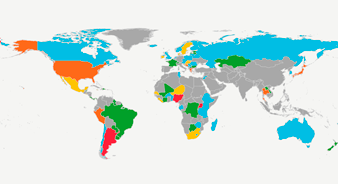Indicator 6.3.2 “Proportion of bodies of water with good ambient water quality”
Target 6.3 seeks to halve the proportion of untreated wastewater discharged into our water bodies – this page explains why and how to monitor progress towards the target.
The indicator at a glance
The indicator tracks the percentage of water bodies (rivers, lakes and groundwater) in a country with good ambient water quality. “Good” indicates an ambient water quality that does not damage ecosystem function or human health according to core ambient water quality parameter groups that are relevant globally.
For the purpose of global reporting (level 1 of the indicator), overall water quality is estimated based on an index, which incorporates data on five core parameter groups, which inform on major water quality impairments present in many parts of the world:
- oxygen (surface water).
- salinity (surface water and groundwater).
- nitrogen (surface water and groundwater).
- phosphorus (surface water).
- acidification (surface water and groundwater).
The methodology calls for in-situ measurements of these water quality parameter groups. The measured values are compared to national target levels for the different parameters, and if values meet targets 80 per cent or more of the time, the water body is classified as good.
In addition, countries are also invited to provide more detailed reporting on its ambient water quality (level 2 of the indicator), incorporating any data on any water quality parameter that they consider relevant. For example, they can include data on heavy metals or biological parameters, or data collected through approaches other than the basic physical and chemical methods used for level 1, such as satellite-based earth observation techniques or citizen science initiatives.
Level 1 reporting is important to track global progress and enable cross-country comparison, whereas level 2 reporting is important to properly address all aspects of SDG target 6.3 at the national level.
Available support
The United Nations Environment Programme (UNEP) is the custodian of indicator 6.3.2. For any enquiries about available support, please contact their helpdesk. All support materials are available through the SDG Indicator 6.3.2 Support Platform.
Guidance on data collection and reporting
- UNEP: Monitoring methodology.
- UNEP: Introduction to SDG Indicator. 6.3.2.
- UNEP: Reporting guidelines.
- UNEP: Technical documents.
- UNEP: Country case studies.
- UNEP: Resource repository.
- UN-Water: Data collection process and timeline.
Online support
- UNEP: Helpdesk (email, phone, video conference).
- UNEP: Indicator Calculation Services (contact the helpdesk).
Data and progress reporting
- UN-Water: SDG 6 Data Portal.
- UNEP on behalf of UN-Water: 2018 Progress Report.
- UNEP on behalf of UN-Water: 2021 Progress Report (including infographics).
- UNEP on behalf of UN-Water: 2024 Progress Report (including visual summary, infographic and video).
- UNEP: 2019 SDG Indicator 6.3.2 Feedback Report.

Why monitor water quality?
Ambient water quality data provide a picture of water body health over time, and help identify pollution hotspots. This can inform the enforcement of pollution laws and discharge permits.
